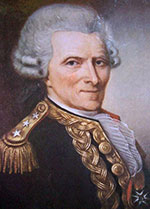Clement de La Jonquière

Fransk admiral.
- Finisterre Kap I, 1747
The subject of this biographical sketch, as is the case for so many of the French leaders of 18th century Canada, had a most impressive name: Marquis de la Jonquière, Taffanel de la, Jacques-Pierre de Jonquière. Born at the family's chateau in southern France, Jonquière entered the navy at the age of 12 years. As a young naval officer, Jonquière was to see considerable action and sailed the varied waters stretching from the Mediterranean to the Caribbean, from those off of North Africa to the waters of Acadia. During his time, he was involved in many sea battles. In the late 1720s he was a commander of a naval frigate and was employed in the West Indians chasing pirates.1
In 1733, Jonquière was the made the captain of the Rubis which was employed convoying ships back and forth from France to New France. After that he was working in the Mediterranean; but, in 1738, was back in charge of the Rubis and again convoying the supply ships to Louisbourg and Quebec. In the years between 1739-1745, war years, Jonquière was to be involved in further sea battles. In March of 1746, he was promoted to rear-admiral and appointed the Governor of New France. In that year, 1746, he intended to take up his duties at Quebec; but -- things got in the way.
In 1746, Jonquière sailed across the Atlantic with the doomed d'Anville armada, a fleet consisting of better than 70 vessels. The fleet was to suffer much in its long and stormy Atlantic crossing. Shortly after the fleet's arrival at Chebucto (Halifax), Duc d'Anville died, and, promptly thereafter, the second in command tried to commit suicide. Jonquière, as the most senior officer, took command. Though Jonquière tried to revive the forces in order to attack Annapolis Royal, in October of 1746, another Atlantic storm hit the reduced fleet of 42 ships and Jonquière was obliged to make the decision to return home to France with his battered ships and sick men.
La Jonquière, it would appear, was held little responsible for the d'Anville disaster of 1746, for, he was outfitted once again and put in command of a large convoy, a fleet of vessels, a number of which were meant for Quebec. An English fleet of men-of-war were to come upon them just after they left France, off the north west corner of Spain, The Battle of Cape Finisterre (April, 1747) was thereafter to unfold. The French came off second best; Jonquière was wounded, captured and brought to England, there to spend two years as a prisoner.
While appointed to the governorship of New France in 1746, do to his prolonged sojourn in England, Jonquière was not to arrive at Quebec until the late summer or early fall of 1749. His active administration of the affairs of New France lasted for a period of less than three years. He was then in his mid sixties and his health was slipping. His administration was soon to come under criticism.
The accounts of la Jonquière, that I have read, show that he was a man of great courage. His naval career consisted of 29 campaigns and nine combats. He liked money (not that that should make him so unusual); and this like, got him into difficulty during his last years as the governor at Quebec. Maybe he came too much under the influence of the infamous Bigot who was with la Jonquière both during the d'Anville disaster in 1746, and, with him at Quebec as the Intendant. In any event, Jonquière got himself involved in some illegal pelt trading which upset certain of the licensed traders at Quebec. Indeed, charges were to be laid before the court at Versailles, and, if the process had been allowed to run its course, it would have likely have led to Jonquière's recall. Jonquière escaped being obliged to answer the charges laid at Versailles, for, in the spring of 1752, at Quebec, after some months of illness, and while still carrying the seals of his office, the Marquis de la Jonquière was to die.